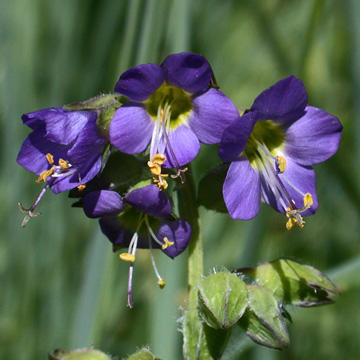

Polemonium vanbruntiae - (image 1 of 6)
Taxonomy
Family: Polemoniaceae
Habitat
Swamps and wet meadows, stream banks. Prefers partly-shaded habitats and subacid to circumneutral soils.
Associates
Distribution
Quebec, ME, VT, and northern NY to WV. Extirpated from NJ and New Brunswick.
Morphology
Erect perennial, 40-100 cm, the upper internodes elongate; leaves alternate, pinnately compound with 7-10 pairs of lance-shaped leaflets 2-4(-7) cm long and sharply acute; basal leaves long-petiolate, the cauline less so or the upper sessile; calyx at anthesis 8-10 mm long, usually longer than the pedicel, the lobes longer than wide; corollas blue-purple with yellow centers, 14-20 mm, lobed to about the middle, the lobes more or less erose; stamens surpassing the corollas by 5-7 mm.
Notes
Flowers early June to July
Wetland indicator: FACW
This species is endemic to the northeast. It is globally vulnerable (G3G4), with most populations occurring in the Catskill Mountains, Tug Hill Plateau, and Allegheny Plateau of NY. A few new populations have been found in Central NY in recent years. It has a similar range to Trollius laxus and occupies similar habitats, though Trollius laxus prefers more calcareous wetlands.
References
Gleason, Henry A. and A. Cronquist. 1991. Manual of Vascular Plants of Northeastern United States and Adjacent Canada. Second Ed.
The New York Botanical Garden. Bronx, NY
USDA, NRCS. 2002. The PLANTS Database, Version 3.5 (http://plants.usda.gov).
National Plant Data Center, Baton Rouge, LA 70874-4490 USA.
|
Michael Hough © 2018 |